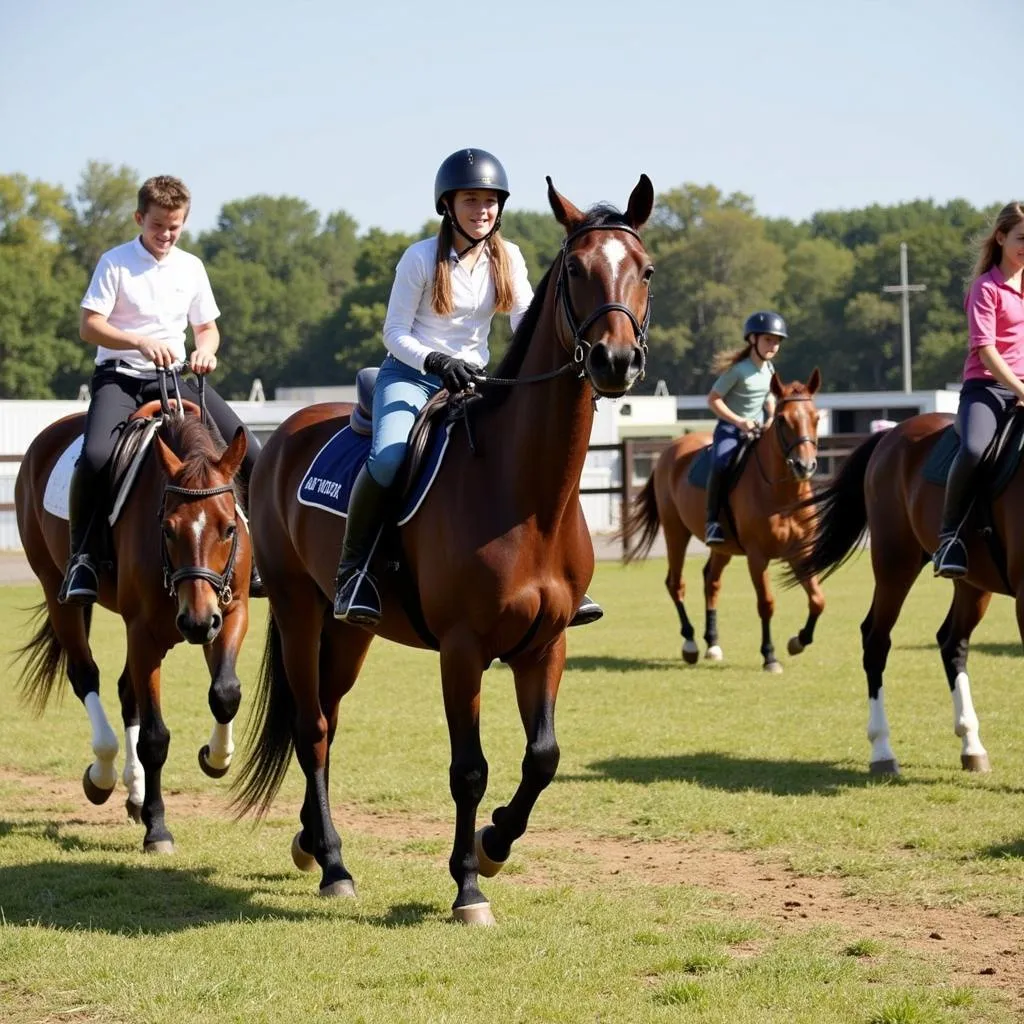Starting your journey in horseback riding can be incredibly exciting and rewarding. But it’s essential to have a solid foundation of skills and knowledge to ensure a safe and enjoyable experience. This is where well-structured lesson plans come in!
Whether you’re a complete beginner or have some prior experience, these lesson plans are designed to help you progress gradually and build confidence in the saddle. They cover essential riding techniques, safety precautions, and horse care basics.
The Importance of Structured Lesson Plans
Imagine trying to learn a new skill without clear guidance. It would be difficult, frustrating, and possibly unsafe. The same principle applies to riding. Lesson plans provide:
- Clarity and Direction: They outline specific learning objectives and steps, ensuring you progress systematically.
- Safety First: Clear instructions on horse safety and proper handling are crucial for both you and your equine partner.
- Confidence Building: Each successful lesson step increases your confidence, helping you tackle more complex riding skills.
- Enjoyable Learning: Well-structured lessons keep things fun and engaging, promoting a positive experience.
Sample Lesson Plan for Beginners
This plan focuses on basic skills and introduces the fundamentals of riding.
Lesson 1: Getting Acquainted with Horses
Objectives:
- Understand horse behavior and body language
- Learn how to approach and handle a horse safely
- Practice basic grooming techniques
Activities:
- Introduction: Discuss horse safety, handling, and basic anatomy.
- Groundwork: Learn to approach a horse calmly, use leading reins, and understand horse cues.
- Grooming: Practice brushing, picking hooves, and checking for any injuries.
- Horse Care: Learn the basics of feeding and watering.
- Safety Review: Reiterate important safety guidelines, including never running around horses.
Time: 60 minutes
Lesson 2: Saddle Up and Mount
Objectives:
- Understand saddle and bridle parts
- Learn how to saddle a horse correctly
- Practice mounting and dismounting safely
Activities:
- Saddling: Review saddle and bridle parts. Practice saddling with guidance.
- Mounting: Learn proper foot placement and mounting techniques.
- Dismounting: Practice dismounting safely and securely.
- Walking: Get comfortable with walking in the saddle, using reins and leg cues.
- Safety Review: Reiterate the importance of safety around horses, especially while mounting and dismounting.
Time: 75 minutes
Intermediate Lesson Plans: Refining Your Riding Skills
As you progress, the lesson plans become more complex, focusing on:
- Riding Techniques: Developing a consistent seat, using leg aids for steering and control, and maintaining a balanced position.
- Horse Communication: Learning how to communicate with your horse through voice, body language, and reins.
- Riding Patterns: Maneuvering in specific patterns like circles and straight lines.
- Obstacles: Overcoming simple obstacles like poles and cavaletti.
- Advanced Skills: Trotting, cantering, and even jumping (with careful supervision and progression).
Building a Solid Foundation
“Just remember, good riding starts with a solid foundation,” says expert equestrian, Sarah Thompson. “Mastering the basics is essential for a successful and enjoyable riding experience. Don’t rush the process and focus on mastering each stage before moving on.”
The Importance of a Qualified Instructor
“Finding a good instructor is crucial,” shares Michael Davies, a renowned riding coach. “A skilled and experienced instructor can provide personalized feedback, correct mistakes, and guide you through the learning process safely.”
Creating Your Own Lesson Plans
Here are some tips for creating your own lesson plans:
- Identify Learning Goals: Determine what you want to achieve in each lesson.
- Break Down Steps: Divide your goals into manageable steps.
- Consider Time Limitations: Allocate sufficient time for each step.
- Prioritize Safety: Safety should always be paramount.
- Be Flexible: Adjust the plan as needed based on progress and individual needs.
Frequently Asked Questions (FAQ)
Q1: What should I wear for riding lessons?
A: Comfortable, close-fitting clothing that allows for movement is essential. Long pants, riding boots, and a helmet are recommended.
Q2: How often should I take lessons?
A: The frequency depends on your individual goals and progress. One to two lessons per week is a good starting point.
Q3: What if I’m afraid of horses?
A: It’s perfectly normal to feel apprehensive. A good instructor will address your concerns and help you build confidence gradually.
Next Steps: Embark on Your Riding Journey
With a clear plan and guidance from a qualified instructor, you can embark on your exciting riding adventure. Remember to enjoy the process, stay patient, and celebrate your progress along the way.
 Novice Riders Enjoying Their Lesson
Novice Riders Enjoying Their Lesson
Don’t hesitate to contact us if you have any questions or need help finding a qualified instructor. We’re here to support you every step of the way!